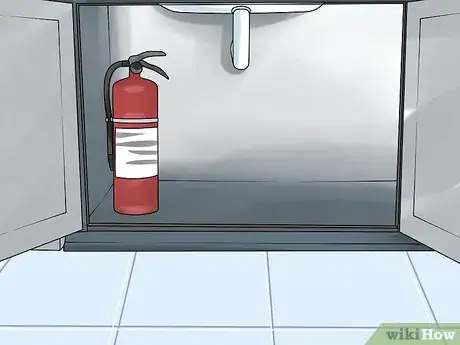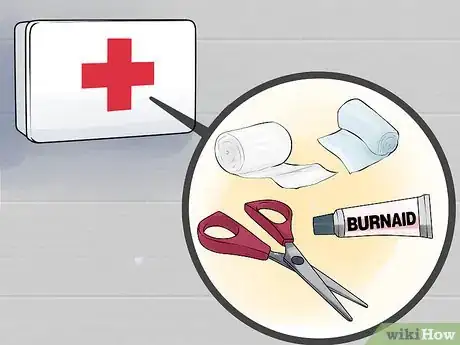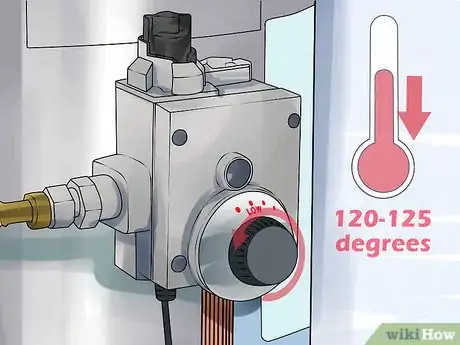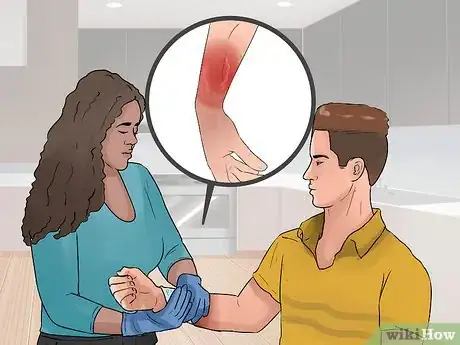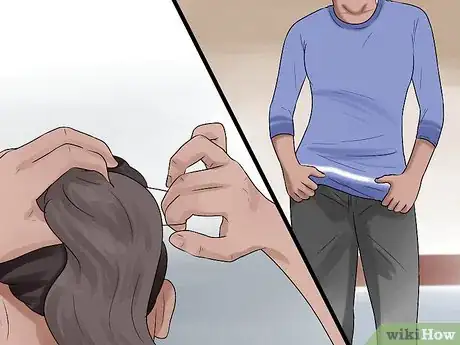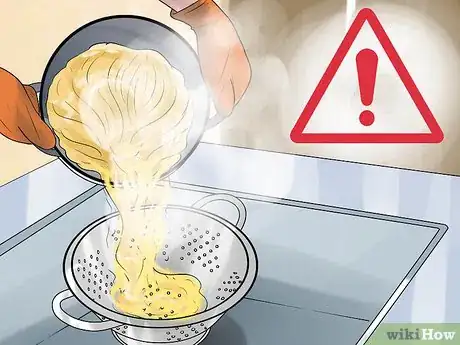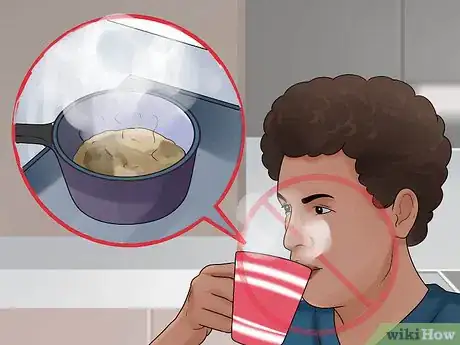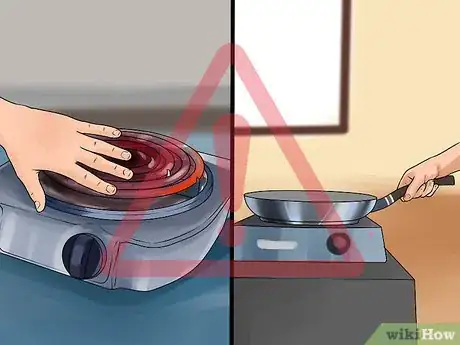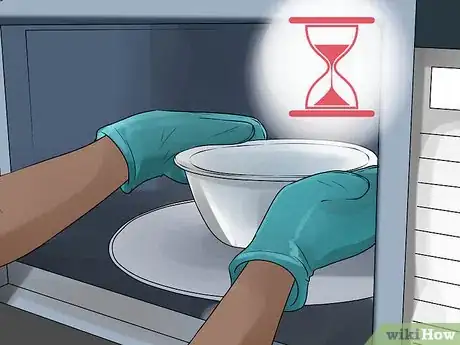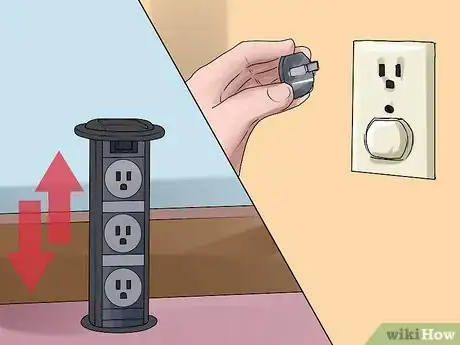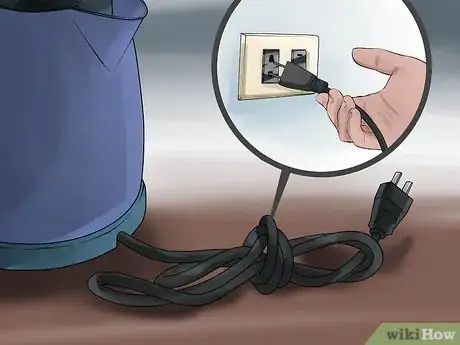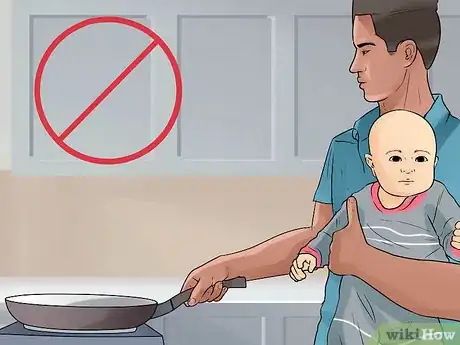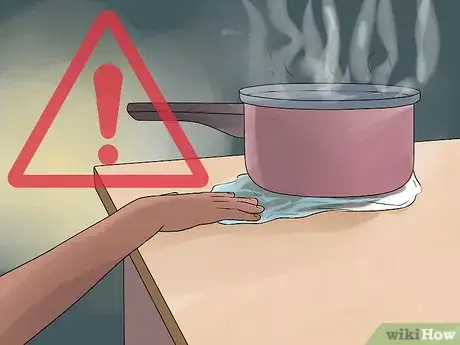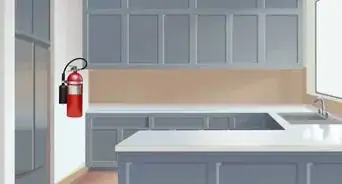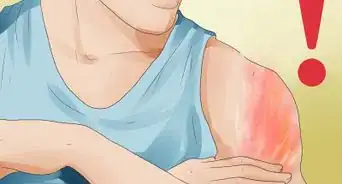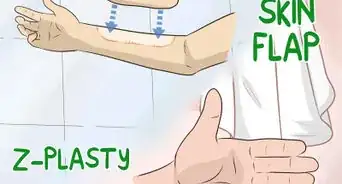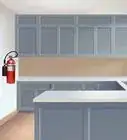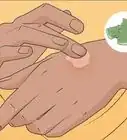This article was co-authored by Jurdy Dugdale, RN. Jurdy Dugdale is a Registered Nurse in Florida. She received her Nursing License from the Florida Board of Nursing in 1989.
There are 13 references cited in this article, which can be found at the bottom of the page.
This article has been viewed 48,060 times.
Kitchen burns happen quickly and frighteningly easily. With a few safety precautions and preparation, you have a good chance of preventing most kitchen burns. Learning how to prevent these burns requires common sense and adherence to simple safety rules every time you cook or work in the kitchen. Take special care when cooking and serving food, especially when young children are present.
Steps
Taking Appropriate Precautions
-
1Make fire extinguishers accessible. Whether you’re in a home or commercial kitchen, you need to have access to a fire extinguisher. Fire extinguishers do exactly what their name suggests – they extinguish fires with a chemical foam that prevents fires from obtaining more oxygen. These are an excellent tool and can prevent small fires turning into big fires, but remember, your food won’t be edible after you use an extinguisher.[1]
- Commercial kitchens will need to follow their city’s code requirements about how many extinguishers are needed and where they should be located.
- Typically an extinguisher is kept below the kitchen sink in a home kitchen.
-
2Have a first-aid kit. You should have an accessible first-aid kit whether you’re cooking in a commercial or home kitchen. At the minimum, your kit should contain plenty of sterile gauze, bandages, a first-aid burn gel, cling wrap (to cover a burn until you can get treatment), and scissors to cut away any clothing that might be touching the burned area. Periodically check your kit to make sure that the contents are still there and that they aren’t expired.[2]
- Cities will have requirements about what your commercial first-aid kit should contain.
Advertisement -
3Set your hot water heater’s thermostat. Lower your hot water heater’s thermostat to 120 – 125 degrees so that water from the faucet won’t scald you. Water heated above this temperature can cause scalding burns, and is an unsafe temperature, especially if there are children in the house.
- Turning down the temperature on your hot water heater will also save you money. The higher the temperature, the more your water heater has to work to keep the water heated at such a high temperature.
- Consider installing anti-scald devices on tubs or faucets that children can access.
-
4Get trained in first-aid. Whether you’re in a commercial or home kitchen, it’s a great idea to have someone trained in first aid present at all times. If this is a home kitchen, that person will be you, of course. Being trained in first aid will show you a variety of life-saving techniques, and also teach you how to identify and treat burns.[3] [4]
-
5Tie your hair back and wear fitted clothing. Make sure that your hair is not hanging down, exposed to any sort of flame or heat, and that your clothes fit relatively close to your body. Baggy or loose clothing can ignite easily because it hangs much closer to heat sources than the rest of your body. While clothing fires aren’t typical, they do account for 18% of fire-related fatalities.[5]
- If you have long hair, consider keeping a head scarf, hair tie, or hair net in the kitchen to use when you cook.
- Avoid wearing long or loose sleeved clothing while cooking as well because the sleeves can catch on fire.
Preventing Scalding Injuries
-
1Drain pasta and pour hot liquids away from you. When you drain cooked pasta or other hot liquids, you can potentially be burned from the steam or scalded by the boiling water. Make sure that the sink is empty except for the colander, and very slowly pour the pan away from your body and turn your head away from the steam. If anything splashes out, this will prevent hot water from touching you.[6]
- It’s a good idea to wear tall oven mitts or arm protection when you’re pouring hot liquids, as they can prevent your arms from being scalded or burned.
-
2Remove lids away from your body. When you remove a lid from a pot or pan, use the handle and carefully lift the lid away from your body. This directs any steam away from you and prevents you from being scalded by hot steam.[7]
- It is best to do this over the sink.
- If the lid handle is also hot, use an oven mitt or hot pad so that you don’t burn your hand.[8]
-
3Don’t drink or eat scalding hot foods. You may tend to think of burns happening on your hands or skin, but forget that you can also scald your throat and the inside of your mouth. To avoid these painful, and sometimes dangerous, scalding burns, let your hot food or beverage sit for a few minutes to cool down before you ingest them. Also, if you see steam coming from your food or beverage, a good indication that they’re too hot to consume, you can blow on them to cool them down also.[9]
Preventing Burning Injuries
-
1Don’t touch hot surfaces. While it may seem common sense not to touch a hot burner with your bare hand, you should always use caution when touching any surfaces that may be hot. You may forget that a pan is hot, or you may not know that someone recently turned a stove burner off and that it’s still hot. Treat all pans, pots, cookie sheets, and stove burners as hot until you verify that they aren’t.[10]
- Put empty pans, pots, and baking sheets on empty burners while they cool down.
- Wrap potholders around hot handles or set them on top of lids, but make sure that you’re not blocking any steam venting holes in the lid when you put the potholder on there.
- If you need to use your stove but have a pot or pan that needs to cool down at the same time, put your pot or pan on a trivet on the counter. Just make sure that it’s out of the way so that you don’t accidentally bump into it.
-
2Remove foods from the microwave carefully. Take care when using the microwave, as microwaved food may be steaming, boiling, or have reached an internal temperature that will easily burn you. Remove microwave food lids carefully to avoid being scalded. Always assume that food cooked in the microwave is just as hot as food cooked by conventional methods.
- Keep the microwave at a good height for you. If something spills, you will be less likely to get burnt if the item is at arm’s length from you.
- Put a plastic spoon in a cup or other smooth vessels when heating liquid in a microwave. A plastic spoon can prevent the liquid from spattering, preventing possible scalds.
- Read the bottom of a container to make sure it is safe for the microwave oven before using the container to heat foods or liquids. Use only containers marked, "Microwave Safe."
- Purchase microwave ovens that turn off automatically when you open the oven door.
-
3Keep your distance from hot oil. When air bubbles heat up enough, they pop, and if those bubbles are in oil, the oil can “pop” and send bits of hot oil shooting out of the pan. If you’re standing too close, the oil can jump on to your arm, hand, face, or clothes. To prevent yourself from being burned, stand a few feet away from a pan or pot that has hot oil in it. And use long tongs when you work with food in the hot oil.[11]
- If oil or grease catches fire, slide a lid over the pan or pot. This will remove the air that the fire needs to keep burning and put the fire out quickly.
- Under no circumstances should you ever put water on a grease or oil fire. This will only cause the fire to flare up aggressively. Turn off the burner immediately and avoid throwing anything onto the fire.
Safely Working with Children in the Kitchen
-
1Childproof your outlets and appliances. You know to put safety caps on the exposed outlets around your home, and this is especially important in the kitchen. Whichever outlet cover you choose to use, make sure that you unplug appliances when they aren’t in use and cover the outlets. Kitchen outlets are a particular concern because of the proximity of metal objects, such as skewers, forks, keys, or knives, that a child could stick in a live outlet.[12]
-
2Put appliances away. While you don’t have to lock appliances up in a cabinet, you should unplug them when they’re not in use. This is especially important for any appliance that could heat up and burn your child or turn on and cut your child. Consider wrapping each appliance’s cord up so that it’s not only out of reach, but not easily plugged in should your child try to do so.[13]
- Another safety tactic is to put a small lock through the cord’s prongs, which will prevent the plug from being inserted into an outlet.
- It’s also important to put appliances out of a child’s reach, including cords, so that they can’t pull anything down on top of them.
-
3Don’t hold a child while you cook. Even if your child is crying and something on the stove needs your immediate attention, such as a pot boiling over, do not hold your child while you cook. You have to choose which needs your attention more at that moment, your child or the pot on the stove. Unfortunately, when you lift the pot’s lid, steam might rush up and burn the child’s leg, or they might be kicking their feet and accidentally kick the pot or handle to a pan, flipping the hot contents all over both of you.[14]
- Talk to your child and explain what you’re doing so that they understand that you’re not ignoring them.
- You can also talk them through what you’re doing in the kitchen to satisfy their natural curiosity. Try gating the kitchen off so that they can watch you from a safe distance while you explain.
-
4Teach children to cook. From about the age of 18 months on, children’s natural curiosity and desire to help you naturally lend themselves to teaching your child to cook. They will gain skills in reasoning, dexterity, critical thinking, and counting, and, most importantly, kitchen safety. Teaching children to cook allows you to teach them how not to burn themselves while also teaching them important life skills.[15]
- You know best what you should teach your child regarding burn prevention and kitchen safety.
- Cooking together is a fun and educational way to bond with your child.
- Toddlers are great at stirring and spooning ingredients.
- Elementary school-aged children are great at cutting, folding, greasing, and mixing.
- Older children (8-11) can help plan meals and also cook on the stove, with supervision, of course.
- Allow only children who are tall enough to remove food from the microwave oven safely to use a microwave. Children who are too short to reach a microwave oven easily may risk facial burns.
-
5Keep children secured. It’s best to keep children out of the kitchen and away from the oven and stove while you’re cooking, unless they’re helping you and you’re able to supervise them. Consider putting up baby gates that block the entrance to the kitchen or putting your little one in a high chair or playpen when you’re cooking.[16]
- If you let your toddler in the kitchen with you, especially if they are just learning to walk or are holding on to objects to stand up, make sure to keep them away from the oven, as they might burn their hands on a hot oven door.
-
6Prevent children from pulling hot items down on themselves. Children are naturally curious, and may tug on tablecloths or towels that are hanging down within reach. This is especially true for children who are just learning to walk, as they tend to grab the first steady object to hold themselves up. Unfortunately, pulling a tablecloth or towel placed under hot cookware on a counter top or table can be dangerous because the cookware might come down on the child’s head. Position hot vessels away from counter top edges so children can't touch them or grab the handles. Turn pot and pan handles inward so they're not easily reached.
References
- ↑ https://www.osha.gov/SLTC/etools/evacuation/portable_about.html
- ↑ http://www.stjohn.org.nz/First-Aid/First-Aid-Library/Burns/
- ↑ http://familydoctor.org/familydoctor/en/prevention-wellness/staying-healthy/first-aid/first-aid-burns.html
- ↑ https://www.healthychildren.org/English/health-issues/injuries-emergencies/Pages/Treating-and-Preventing-Burns.aspx
- ↑ http://www.nfpa.org/public-education/by-topic/top-causes-of-fire/cooking
- ↑ http://www.barnabashealth.org/Saint-Barnabas-Medical-Center/Our-Services/The-Burn-Center/Community-Outreach/Burn-Prevention-and-Fire-Safety-Tips.aspx
- ↑ https://consumer.healthday.com/encyclopedia/work-and-health-41/occupational-health-news-507/burn-prevention-for-kitchen-workers-646431.html
- ↑ https://www.washingtonpost.com/national/health-science/avoiding-kitchen-cuts-and-burns/2013/01/07/54eaec4a-54fb-11e2-a613-ec8d394535c6_story.html
- ↑ http://hospitals.unm.edu/burn/prevention.shtml
- ↑ https://consumer.healthday.com/encyclopedia/work-and-health-41/occupational-health-news-507/burn-prevention-for-kitchen-workers-646431.html
- ↑ https://consumer.healthday.com/encyclopedia/work-and-health-41/occupational-health-news-507/burn-prevention-for-kitchen-workers-646431.html
- ↑ https://www.safekids.org/tip/burns-and-scalds-prevention-tips
- ↑ https://www.safekids.org/tip/burns-and-scalds-prevention-tips
- ↑ https://www.safekids.org/tip/burns-and-scalds-prevention-tips
- ↑ http://www.bbcgoodfood.com/howto/guide/guide-cookery-skills-age
- ↑ https://www.cdc.gov/safechild/burns/
About This Article
To prevent kitchen burns, place hot pans, pots, and baking sheets on empty burners while they cool down so you don't accidentally touch them. You can also place pot holders on hot handles or lids in case you touch or bump into them. You should also stand a few feet away from pots or pans with hot oil in them since hot oil can splatter and cause burns. To help prevent scalding injuries, always drain pasta and pour hot liquids away from you with your face turned away in case anything splashes. To learn how to safely work with children in the kitchen, scroll down!
